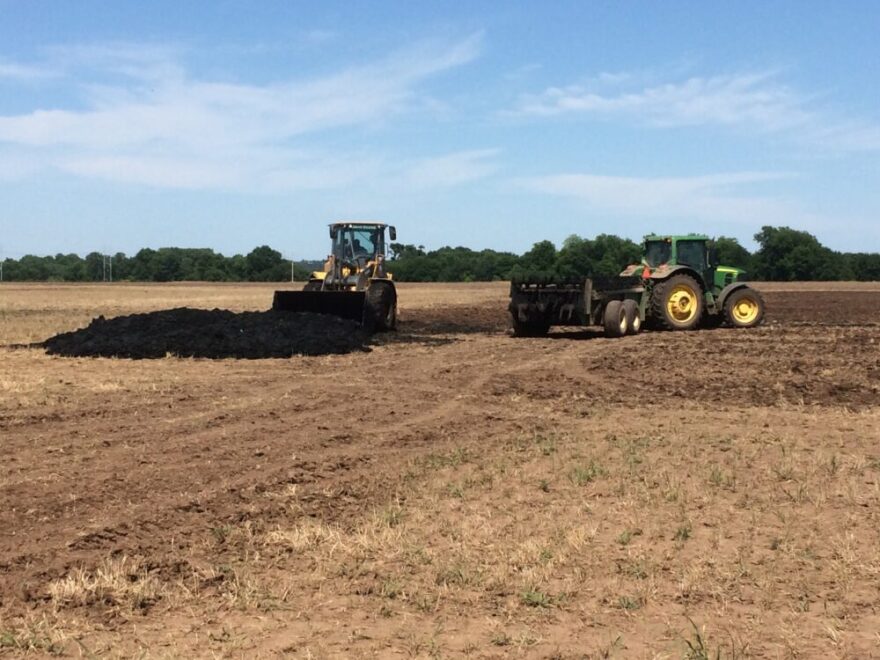The Deer Island Wastewater Treatment Plant is a pollution success story. Over the last several decades, it transformed Boston Harbor from a nationally embarrassing cesspool into a swimmable bay.
The treatment plant takes everything the people of Greater Boston send down their sinks, toilets, showers and washing machines — plus industrial waste — and treats it. The treated water is clean enough to let out into the ocean. The remaining sludge gets recycled into fertilizer that’s used in nearly 20 states.
But now that fertilizer is raising fresh concerns. That’s because wastewater treatment plants like Deer Island were not built to handle the toxic “forever chemicals” known as PFAS.
The treatment process concentrates PFAS chemicals in the sludge, and therefore in the fertilizer, leading environmentalists and public health advocates to call for an immediate end to its use. Others are not sure that a full ban on sludge-based fertilizer, or “biosolids,” is the answer. But there is widespread agreement that we have only begun to grasp the extent of the problem.
“I think we're only starting to discover how important biosolids are as a source of PFAS contamination,” said Heidi Pickard, a Harvard doctoral student who is analyzing soil and corn from farms contaminated by sludge-based fertilizer.
“Most states have not even begun to test to see if biosolids that have been applied to land are contaminated, that soil is contaminated,” Pickard said. “I think if they go and look, they're going to discover that this is a huge contamination issue everywhere.”
The 'pollution sink'
Forty-three communities — about a third of the people in Massachusetts — send their wastewater to Deer Island. Industrial and household waste, stormwater, the liquid that leaks from landfills and the slop pumped out of septic tanks — it’s all tunneled to the plant with its iconic egg-shaped tanks.
On average, the plant receives and treats more than 330 million gallons of wastewater each day, making it the second-largest treatment plant in the country, by volume.
Because thousands of consumer and industrial products — from waterproof cosmetics to toilet paper to firefighting foam — contain PFAS, the wastewater coming into Deer Island, like wastewater everywhere, is contaminated with the chemicals.
“What gets into wastewater is just about everything that we use in our society, because it's the pollution sink for what's out there. Which is a big deal when we’re talking about PFAS,” said Laura Orlando, a civil engineer and senior science advisor for Just Zero, a nonprofit focused on waste.
Treatment plants don’t remove PFAS from wastewater or sludge, and there’s no easy or cost-effective way to do it, Orlando said. It’s also not their job.
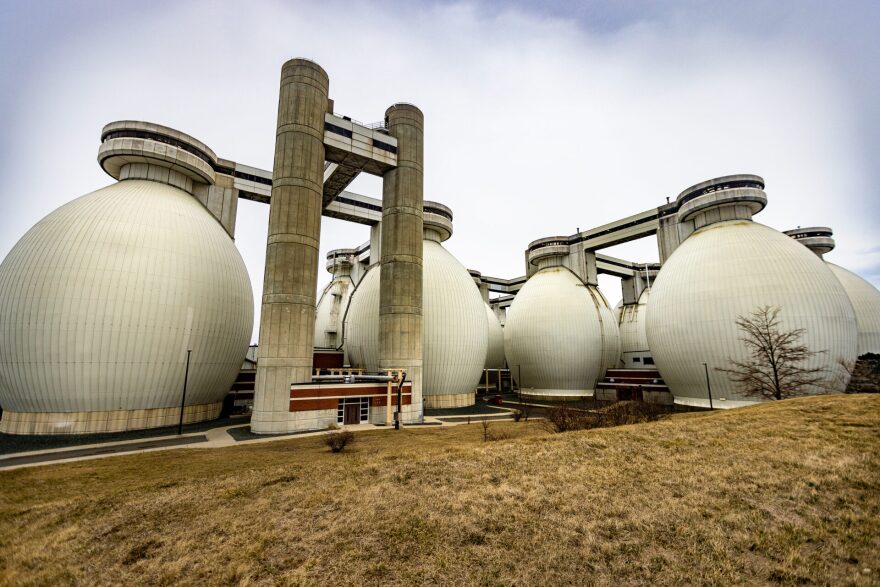
Wastewater treatment plants are designed to remove excess nutrients like nitrogen and phosphorus, kill pathogens and filter out items like gravel and sneakers that find their way into the waste stream. “It's not about, ‘take out this chemical, take out that chemical, reduce your PFAS,’ ” Orlando said.
At Deer Island, part of the treatment process happens inside the giant eggs, which are filled with bacteria happily eating sewage. Each egg can hold 3 million gallons of sludge, storing the warm slurry for weeks at a time.
Inside, microbes drastically reduce the volume of sludge, which is useful because the plant then has less to manage. The microbes also give off methane the plant captures and converts into power.
But there’s something else that happens in the eggs: the heat and microbes can transform PFAS chemicals from one form to another. More specifically, certain PFAS molecules known as "precursors" can chemically change into known PFAS toxins. These toxic PFAS then stick around in their final form. These changes can also happen in other places with microbial activity, like soil.
This chemistry is important. Harvard chemist Elsie Sunderland, who studies PFAS precursors, said that their chemical formulas are often closely held trade secrets, making them difficult to track and measure. Sunderland said the only way to get a real handle on how much PFAS is in sludge, or anything, is to stop counting individual types of PFAS, and instead measure the total mass of molecules with PFAS’s telltale carbon-fluoride bond. But there are only a few commercial labs that can do this. Most tests trace only a handful of PFAS chemicals, rather than the thousands that exist.
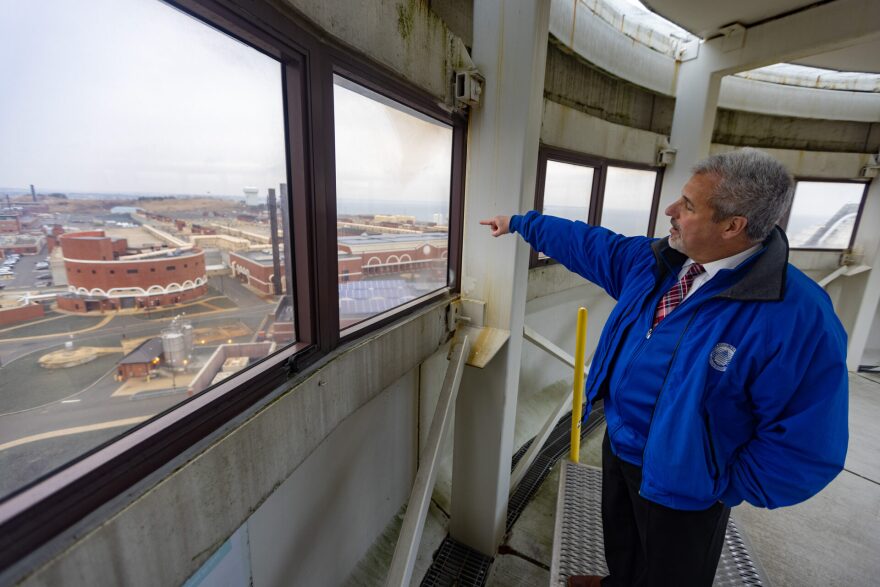
Deer Island has tested its biosolids for 16 PFAS compounds since 2019, and has just begun tracking 40 types. For two of the most concerning molecules, PFOS and PFOA, its monitors find an average of 15 parts per billion combined.
But it’s hard to know what to make of these numbers, and not only because of the measurement problem: right now there’s no state or federal rules that say how much PFAS in biosolids is too much.
A few states have guidelines, but they vary widely. For instance, fertilizer made from Deer Island sludge would be allowed under Michigan’s specs but not Connecticut’s. Maine banned the use of sludge-based fertilizers altogether in 2022, the first and only state to do so. Massachusetts has no guidelines, but regulators are “exploring options.”
Right now, the fertilizer pellets or “biosolids” from Deer Island are used in almost 20 states, including Massachusetts, New York and Pennsylvania. Biosolid-based fertilizers are also sold for home use, according to an analysis by the Sierra Club.
Industry advocates say that turning sludge into fertilizer is a far better option than burning it or throwing it into a landfill.
“We're putting carbon back into the soil. There's a lot of nutrients in there and micronutrients,” said Janine Burke-Wells, executive director of the North East Biosolids and Residuals Association. “And when you see what the material does for the soil, it is pretty amazing.”
Many environmental advocates have long been critical of sludge-based fertilizers because they can contain contaminants like heavy metals. Clint Richmond, toxics policy lead for the Massachusetts chapter of the Sierra Club, points out that there are other “emerging contaminants of concern” in sludge, like microplastics and pharmaceuticals, that are largely unregulated.
“Even if biosolids were PFAS-free, I wouldn't put it on my garden, let's put it that way,” Richmond said.
In Maine, 'A nightmare you can't wake up from'
During the 1980s and '90s, Maine went all-in for sludge-based fertilizer, encouraging residents to spread it onto farms, forests and gardens. Around two-thirds of the sludge from Maine’s wastewater plants was spread on the land, often mixed with compost or industrial waste from paper mills.
That sludge, we know now, was contaminated with PFAS. This became painfully apparent a few years ago, when Maine farmers began finding high levels of PFAS in milk and meat. Several farmers shuttered their farms or culled their herds. Others remain on edge as sampling continues.
“It's like a nightmare you can't wake up from,” said Maine Department of Environmental Protection Commissioner Melanie Loyzim at a legislative briefing in 2022. “People's homes and livelihoods have been destroyed. And the scale of the tragedy keeps growing with every sample that we take."
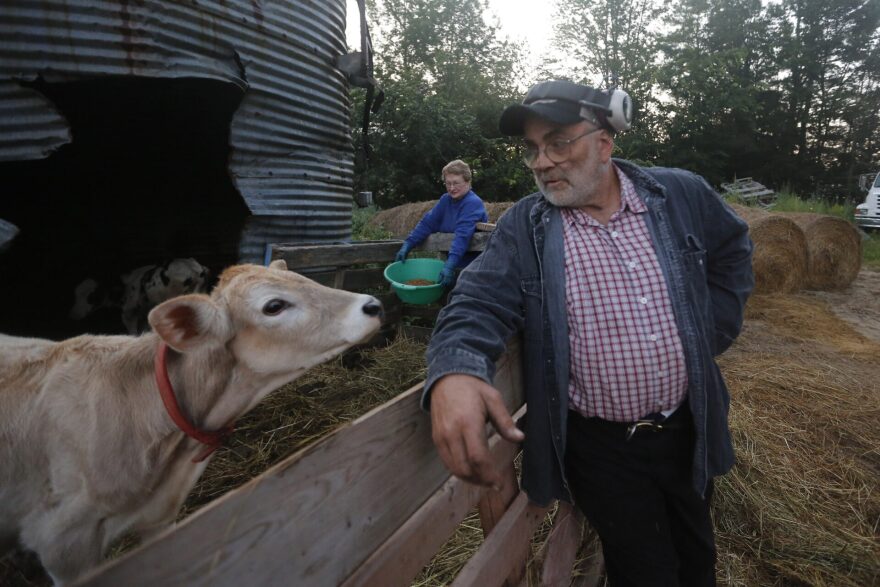
Some of Maine’s problem was likely due to the industrial sludge in the mix, but it's unlikely that this issue is limited to Maine. About half the sewage sludge in the U.S. is made into fertilizer, according to the National Biosolids Data Project. And since 2016, 19.1 billion pounds of sludge have been applied to American farm fields, according to EPA data analyzed by the nonprofit Environmental Working Group (EWG). EWG estimates that 5% of all crop fields in the U.S. — up to 20 million acres — use biosolids as fertilizer.
But because the crisis emerged in Maine, the state has become a leader at studying how PFAS in fertilizer gets into soil, plants and food. Maine state toxicologist Andrew Smith said the data are complicated. For instance, high levels of PFAS seem to end up in corn stalks but not the kernels, and in lettuce but not potatoes. And certain types of PFAS chemicals end up in meat, other types in plants.
“One of the things we've learned is how different the amount of PFAS that can be transferred from soil to plants can be, as you look from one field to another, even for fields on the same farm,” Smith said.
Smith and his colleagues were able to develop PFAS screening levels for soil used to grow hay or corn for dairy cows. But Smith says the latest data are prompting the state to soon revise the levels downward.
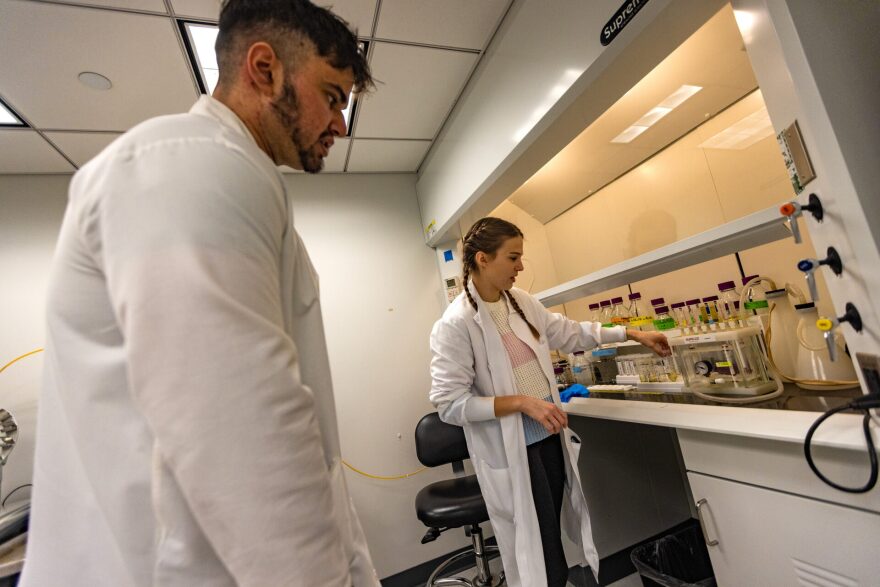
At Elsie Sunderland’s lab at Harvard, her team is studying how some PFAS precursor chemicals transform into others as they work their way into soil and into plants.
“The precursor thing is really important,” Sunderland said. “It's a huge component of the PFAS that we have circulating in the environment, and we know the least about it.”
Given that vast amounts of land and water are now contaminated, understanding PFAS uptake in specific plants and animals may literally save the farm. With more data, farmers might be able to grow certain crops in tainted soil or better map out its remediation.
‘We'll do whatever is necessary’
Since PFAS is now ubiquitous in our environment — found in household dust and 98% of Americans’ blood — some argue that PFAS in fertilizer makes little difference for people's exposure.
But given the growing body of evidence on the chemicals’ harms, many environmental and public health advocates say exposure should be limited everywhere possible, and that includes banning sludge-based fertilizer altogether.
“These forever chemicals … cause harm to human health at very, very, very, very low concentrations to the point where there is no safe concentration of PFAS,” said Just Zero’s Laura Orlando. “The logical thing to do is just not spread it all over the place.”
People in the waste industry agree that PFAS in sludge is concerning. But without guidance from Massachusetts regulators or the EPA, Deer Island’s Director David Duest said the plant’s leaders are waiting for clearer science before deciding where the sludge should go.
“If it works out to be that there's a concern with toxicity, then obviously we'll do whatever is necessary” to protect human health, Duest said.
But, he adds, the sludge has to go somewhere, and the other options are not great. Sending sludge to a landfill or burning it costs more money, wastes nutrients and gives off greenhouse gasses.
These forever chemicals … cause harm to human health at very, very, very, very low concentrations to the point where there is no safe concentration of PFAS. The logical thing to do is just not spread it all over the place.Laura Orlando, Just Zero
There may be other mitigation options. Michigan was able to drastically reduce levels of one PFAS chemical in biosolids by requiring upstream industries to reduce PFAS in their wastewater. Others suggest sludge-based fertilizer might prove safe for tree and turf farms, if not for food crops.
But both waste industry advocates and environmentalists agree that the ultimate solution is much bigger: the government should regulate the whole class of PFAS chemicals, and industry should stop using them as much as possible.
“We need to stop making and using these chemicals in unnecessary products,”said Sonya Lunder, senior toxics policy adviser for the Sierra Club. “They pollute the entire planet at every stage that they pass through.”
“Eliminate it at the source,” said Duest. “Stop manufacturing and using these chemicals.”
The chemical industry may be getting the message. Manufacturing giant 3M, for instance, recently announced it would stop making PFAS by the end of 2025. But some scientists and environmentalists are skeptical.
“3M saying they're going to phase out PFAS chemistry is both great, but also terrifying,” said Harvard's Elsie Sunderland. She said she’s concerned that without better regulation, the industry will switch to unfamiliar chemicals that are more difficult to measure, leaving public health scientists playing “chemical whack-a-mole.”
PFAS chemicals have been unleashed into the world without a full grasp of the consequence, Sunderland said, and without better regulation it’s bound to happen again.
“It is tragic, and it's fully avoidable,” she said. “As a society, we need to demand better regulation of potentially toxic chemicals. It doesn't make any sense that we did this. We just didn't think. So we should think before we create the next one, right? And we should fix this as best we can.”
This story was originally published by WBUR.


